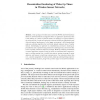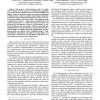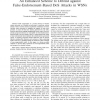25 search results - page 3 / 5 » Impact of mobile node density on detection performance measu... |
MOBIHOC
2002
ACM
14 years 4 months ago
2002
ACM
This paper investigates two fundamental characteristics of a wireless multihop network: its minimum node degree and its k?connectivity. Both topology attributes depend on the spat...
TMC
2010
13 years 3 months ago
2010
—Recent years have witnessed the deployments of wireless sensor networks in a class of mission-critical applications such as object detection and tracking. These applications oft...
EWSN
2007
Springer
14 years 4 months ago
2007
Springer
Duty-cycling in wireless sensor networks (WSNs) has both beneficial effects on network lifetime and negative effects on application performance due to the inability of a sensor to ...
INFOCOM
2005
IEEE
13 years 10 months ago
2005
IEEE
—The presence of heterogeneous nodes (i.e., nodes with an enhanced energy capacity or communication capability) in a sensor network is known to increase network reliability and l...
WIMOB
2008
IEEE
13 years 11 months ago
2008
IEEE
— Node compromise is a serious threat in wireless sensor networks, as it enables an adversary to perform various attacks. Many security schemes exploit the redundancy of many wir...



